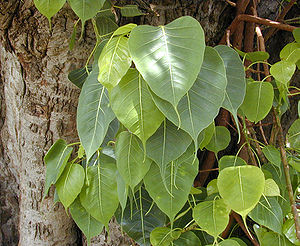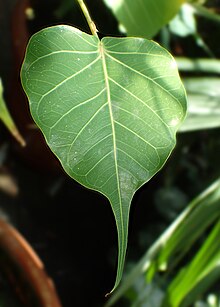Poplar fig
| Poplar fig | ||||||||||||
|---|---|---|---|---|---|---|---|---|---|---|---|---|

Ficus religiosa |
||||||||||||
| Systematics | ||||||||||||
|
||||||||||||
| Scientific name | ||||||||||||
| Ficus religiosa | ||||||||||||
| L. |
The poplar fig ( Ficus religiosa ), also known as the holy fig tree, Indian pepul tree, pepul tree, pipal tree, buddha tree, bodhi tree, bob tree, pho tree or aswattha tree , is a species of figs ( Ficus ) within the mulberry family ( Moraceae ) . It comes from the Indian subcontinent and Indochina .
description
Vegetative characteristics
Depending on its location, Ficus religiosa grows as an evergreen or deciduous tree that reaches heights of 6 to 15, rarely 20 to 30 meters and is therefore medium to large in size. Air roots are rarely formed. Most trunk diameters of 2 to 3 meters are achieved. It has spread branches. The bark of young twigs is hairy. The cracked bark is gray.
The alternate arranged at the branch leaves are divided into petiole and leaf blade. The light green, thin, petiole-round petiole is usually 5 to 10 (4 to 11) centimeters long. When it shoots, the leaves are pink. The simple leaf blade is usually 6 to 15 (4.5 to 8) centimeters long and 4 to 11, rarely up to 14 centimeters, trowel-shaped, ovoid or almost circular. The leaf margin is smooth or ± wavy . There are three to five main nerves on the truncated or heart-shaped base of the blade. The leaf blades , which are relatively soft compared to other Ficus species, end abruptly in trickle tips that are almost half the length of the leaf blade. There are six to nine pairs of lateral nerves and some zigzag intercostal fields. The yellowish-brown stipules are 8 to 12 millimeters long and delta-shaped with a pointed end. Cystolites are only present on the underside. The bare stipules are 0.5 to 3 inches long.
Generative characteristics
In the leaf axils sit in pairs sessile inflorescences (the Pseudanthium of the Moraceae is called "Hypanthodium"). Many flowers are sunk into such an inflorescence , a jug-shaped, hollowed-out axis tissue . Under the inflorescence there are three bracts, which are silky-downy hairy to glabrous and 3 to 5 millimeters long and ovoid-elliptical with a blunt upper end. The yellowish-green hypanthodium has a diameter of 5 to 6 millimeters. Only a small distal opening (ostiolum), narrowed by scales, in this species by three bracts , remains as a connection to the outside. There are no bristles in the hypanthodium.
The flowers are always unisexual and apetal (without petals). There are three types of flowers in a hypanthodium: male and fertile female flowers and sterile female flowers (gall flowers). If there are all-male flowers, then they are in a single whorl. The male flowers have two to three free ovate-lanceolate sepals and one to three stamens . The fertile female flowers and gallblades are sessile or petiolate. The fertile female flowers and gall flowers usually have three or four, rarely up to five, lanceolate sepals. The fertile female flowers have a free ovary .
The fruit is a seed-like achene . There is a fruit association (achene fruit association), more precisely a sykonium, hypanthodium ( false fruit , pseudocarp), as the many female flowers develop into achenes and are integrated into the fleshy, jar-shaped flower base.
Chromosome set
The basic chromosome number is x = 13; there is diploidy with a chromosome number of 2n = 26.
distribution
Ficus religiosa is native to the Indian subcontinent and Indochina . It is found in Sri Lanka , Bangladesh , northern India , Nepal , Pakistan , Myanmar , northern Thailand and northern Vietnam . Ficus religiosa is cultivated in many other tropical areas.
Systematics
The first publication of Ficus religiosa was carried out in 1753 by Linnaeus in Species Plantarum , 2, page 1059. A synonym for Ficus religiosa L. is Urostigma religiosum (L.) gasp.
The type Ficus religiosa belongs to subsection Urostigma the section Urostigma of the subgenus Urostigma in the genus Ficus .
use
Ficus religiosa leaves are used as food for silkworms and other insects.
The bodhi tree is used in tropical areas as an ornamental plant in parks, temples and streets. Very rarely does it serve as a large pot plant in rooms.
It is mentioned that Ficus religiosa is used in folk medicine.
The bodhi tree in Buddhism
According to Buddhist tradition, Siddhartha Gautama experienced the "awakening" ( Sanskrit : Bodhi , often imprecisely translated as "enlightenment") while sitting under a poplar fig and thus became a Buddha ( "awakened" ). The poplar fig has been a symbol of the Buddha in Buddhist art ever since . It is often depicted in reliefs and pictures of Buddhist temples.
In the Indian Bodhgaya , the former Uruvela, next to the Mahabodhi temple stands an alleged descendant of the original Bodhi tree, under which the Buddha attained Bodhi. There is historical evidence that a branch of the original tree was found during Emperor Ashoka's mission in the 3rd century BC. Came to Sri Lanka. The tree that grew from it, the Sri Mahabodhi in the then royal capital Anuradhapura , is still an important place of pilgrimage for Buddhists today. After the original Bodhi tree in Bodhgaya was felled by a Shivaite ruler, an offshoot from Anuradhapura was later planted in its place. This is said to be the tree standing in Bodhgaya today.
In the temple architecture of Sri Lanka it became customary to erect open buildings , specifically called Bodhi Gara , around a living Bodhi tree, which must also be an offshoot from Anuradhapura (thus a second order offshoot of the original Bodhi tree). Also in temples in Southeast Asia, for example the wats in Thailand , there is usually at least one bodhi tree that is the focus of rites during the Vesakh festival during the full moon in April or May.
Mahabodhi in Bodh Gaya , India
Bodhi tree near the Sri Mahabodhi in Anuradhapura , Sri Lanka
Pho tree with ingrown Buddha head in Wat Mahathat Ayutthaya , Thailand
Individual evidence
- ↑ a b c d e f g h Ficus religiosa in the Germplasm Resources Information Network (GRIN), USDA , ARS , National Genetic Resources Program. National Germplasm Resources Laboratory, Beltsville, Maryland. Retrieved June 3, 2018.
- ↑ a b c d e f g h i j k l m n o p q Ficus religiosa at Tropicos.org. In: Flora of Pakistan . Missouri Botanical Garden, St. Louis
- ↑ a b Ficus religiosa at Tropicos.org. In: Flora Mesoamericana . Missouri Botanical Garden, St. Louis
- ^ Ficus religiosa at Tropicos.org. In: IPCN Chromosome Reports . Missouri Botanical Garden, St. Louis
- ^ Linnaeus scanned in at biodiversitylibrary.org in 1753 .
- ^ Ficus religiosa at Tropicos.org. Missouri Botanical Garden, St. Louis, accessed June 2, 2018.
- ↑ Buddha's enlightenment under the Bodhi tree. (PDF) In: Andrea Liebers, The Secret of Buddha, Peter Hammer Verlag 2007. September 8, 2016, accessed on November 21, 2019 .
- ↑ Anuradhapura. (Text and film) In: SWR Treasures of the World. May 2, 2011, accessed November 21, 2019 .
Web links
- Ficus religiosa at Tropicos.org. In: Flora de Nicaragua . Missouri Botanical Garden, St. Louis
- The life of the Buddha - the "holy" tree ( Memento from March 4, 2016 in the Internet Archive ) Quote from: Hans Wolfgang Schumann: The historical Buddha. Diederich's Yellow Series, Eugen Diederichs-Verlag, Munich 1982.









